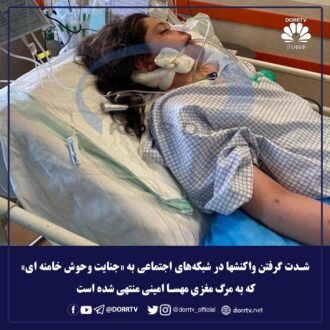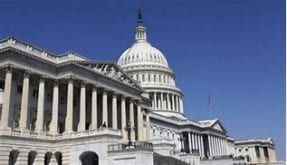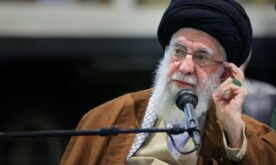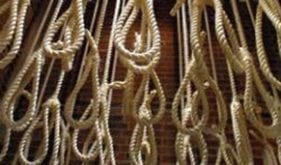Iranwire – It has been a year since Mahsa Amini died in the custody of the morality police. Since then, at least 537 people, including 71 children and teenagers, have been killed by the repressive forces of the Islamic Republic. Tens of thousands of people have tasted prison life and torture.
Senior officials of the Islamic Republic have used the resources of their propaganda machinery to claim that protesters were few, that they were either thugs or the victims of deception by the “enemy.” On the other hand, women’s resistance against mandatory hijab and young Iranians’ calls for justice and freedom have bestowed glory on these 12 months.
***
September 2022: Mahsa Amini’s Death and the Outbreak of Nationwide Protests
On September 13, a young woman who was visiting Tehran with her family was arrested by morality police outside a metro station. The next day, it was reported on Twitter that she was in a coma and, in an interview with her brother, IranWire became the first media outlet that published Mahsa (Jina) Amini’s name and a picture of her.
On September 15, small crowds rallied outside Tehran’s Kasra Hospital where Mahsa Amini was taken after falling into a coma. A picture showing the 22-year-old woman on a hospital bed, intubated for breathing, made Iranians both sad and enraged.
In the afternoon of September 16, Mahsa Amini died after she was taken off the life support system. Her brother had told IranWire that at 8:00 p.m. on September 14 the doctors had informed the family that “it was all over.”
Eyewitnesses reported that security forces used batons and teargas to disperse crowds which had gathered in the streets around Kasra Hospital.
The Islamic Republic’s security agencies pressured Mahsa’s family to bury their daughter “without any ceremony” and far away from Tehran in order to prevent “unrest” in the capital.
On September 17, Mahsa’s body was buried in Aichi Cemetery in the Kurdish city of Saqqez, her birthplace. Thousands of residents gathered in front of the governor’s office to protest after the burial. The protesters chanted “Woman, Life, Freedom,” and women took off their headscarves and waved them in the air. “Beloved Jina: You will not die. Your name is now a symbol” was written on her gravestone in Kurdish language.
The first reports of shootings at protesters emerged on September 19. Fouad Ghadimi, a 40-year-old man from Divandarreh in Kurdistan province and the father of two, became the first person to be killed by security forces during the “Woman, Life, Freedom”’ protests.
From September 20 to 22, thousands of people took to the streets across Iran to protest the murder of Mahsa Amini. Security forces used military grade weapons, shotguns and batons to crack down on the demonstrators. Teenagers such as Nika Shakarami and Sarina Esmailzadeh and young women such as Hadis Najafi were among those murdered in the most brutal way during these days.
While the government’s agents of repression were killing, arresting and torturing thousands of protesters, the Islamic Republic’s propaganda machine relayed statements by government officials who claimed that Mahsa Amini died as a result of an illness and said that President Ebrahim Raisi called her family to offer his condolences. All in all, they tried their best to give the public a completely distorted version of reality.
However, in an interview with the Tehran newspaper Ham Mihan on September 18, Amjad Amini, Mahsa’s father, denied that his daughter had been suffering from epilepsy or another underlying disease. “Her worst sickness was catching a cold,” he said. And two of her classmates told the BBC that they weren’t aware that Mahsa had ever been in hospital before.
On September 23, school and universities were reopened after two years of closure due to the COVID pandemic and immediately turned into an arena of struggle against tyranny.
September 30 became known as Zahedan’s Bloody Friday. Following the rape of a 15-year-old Baluch girl by a security forces commander in Chabahar, people rallied in the streets of Zahedan, the provincial capital of Sistan and Baluchistan, after Friday prayers to demand the officer be punished. The protesters were attacked by security and military forces, which killed at least 108 men, women, children and teenagers.
The Islamic Revolutionary Guard Corps (IRGC) first claimed that the members of the Salafist terrorist group Jaish al-Adl (Army of Justice) opened fire on the crowds. When it became clear that the shots had been fired from the roof of a police station, the government claimed that the protestors were planning to attack the facility. But eyewitnesses and Baluch human rights organizations rejected this narrative, emphasizing that the victims were peaceful protesters.
October 2022: Resistance in the Streets, Schools and Universities
Many pictures and videos of peaceful protests by high school students, particularly girls, were posted online. They gathered in schoolyards, took off their headscarves, chanted “Woman, Life, Freedom,” tore pictures of the Islamic Republic’s current supreme leader and his predecessor out of their textbooks and set them on fire. There were also many reports of security forces entering the schools and threatening, arresting and harassing students. In Ardabil, 15-year-old Asra Panahi died in hospital after being brutally beaten by government agents in Shahed High School.
State TV cited Asra’s uncle as saying in an interview that the teenager had underlying heart problems and that the cause of her death was cardiac arrest. Later, however, the Iranian football star Ali Daei, who was born in Ardabil and expressed his support for the protests, rejected this on Instagram and urged the authorities to tell the truth. “History has proven who the liars are,” he wrote.
Meanwhile, tens of universities became the scenes of daily protests which extended to the streets in the afternoons.
On October 2, Khodanoor Lejaei, a 27-year-old Baluch man who had been arrested and tied to a flagpole at a police station, died after being shot in his kidney. A picture of him with his hands tied to the flagpole with a bottle of water put in front of him – but out of his reach – became a symbol of the 2022 protests, as did a video of him dancing.
On the same day, security forces stormed Sharif University of Technology in Tehran where students were staging a sit-in. Plainclothes agents used shotguns, plastic bullets and tear gas against the protesters and brutally arrested at least 100 students and professors. One video shows clashes between the plainclothesmen and students in the parking lot of Sharif University.
On October 15, while many Iranian cities were rocked by anti-government protests, eyewitnesses reported hearing explosions and seeing smoke rising from Evin Prison in Tehran. The judiciary claimed the fire was caused by a “riot” and that eight inmates died from smoke inhalation. However, evidence suggests that the blaze was intentional and meant to cover up the shooting of prisoners. Sources told IranWire that at least 13 people lost their lives in the incident. And according to a list obtained by IranWire, at least eleven political prisoners were injured.
Since the death of Mahsa Amini, many Iranians around the world have voiced support for the “Woman, Life, Freedom” uprising. On October 22, tens of thousands of Iranian expatriates marched in Berlin in a massive show of solidarity with the demonstrators in Iran.
Iranians traditionally mark the 40th day after a person’s death as part of the mourning process. On October 26, demonstrators took to the streets of Isfahan, Mashhad, Tabriz, Urmia, Saqqez and dozens of other Iranian cities to mark the 40th day since Mahsa Amini had lost her life, while student protests continued to paralyze dozens of universities.
Security forces opened fire at mourners gathered at Aichi cemetery in Saqqez, where Mahsa Amini is buried. The demonstrators shouted “Kurdistan, Kurdistan, the graveyard of fascists” and “Death to the dictator.”
November 2022: The Anniversary of the 2019 Protests and Kian Pirfalak’s Death
Hadis Najafi, a 20-year-old woman, was shot on September 21 in the abdomen, neck, heart and hand by security forces in Karaj, near Tehran. Forty days later, on November 3, protesters gathered around Behesht Sakineh Cemetery in Karaj’s Mehra Shahr suburb and were quickly confronted by security forces who opened fire at them. Tens of people were killed across the country on that day, including in Karaj.
Also on November 3, the government claimed that a member of the paramilitary Basij force by the name of Ruhollah Ajamian was killed by “rioters” in Behesht Sakineh Cemetery. Eleven people were charged over their alleged involvement in Ajamian’s death, including a child. Two of them, Mohammad Mehdi Karami and Seyyed Mohammad Hosseini, were hanged in January 2023 after a sham trial.
On November 15, 16 and 17, Iranians took to the streets to mark the anniversary of the November 2019 protests during which hundreds of people were killed or injured. According to reports, tens of people were killed in Kurdish towns such as Mahabad, Bukan, Saqqez, Sanandaj and Divandarreh.
On November 16, Kian Pirfalak, a nine-year-old boy, was killed when a stray bullet hit his parent’s car in the city of Izeh, Khuzestan province. His father was critically injured and was hospitalized. A picture of Kian’s body lying in ice at home instead of in a morgue over fear it could be taken away by security forces shocked Iranians, as did a speech by his mother Mahmonir Molaei-Rad during his funeral in which she rejected the government’s claim that Kian had been killed by terrorists.
On November 19, 20 and 21, the Iranian Kurdish region was the scene of massacres. Tens of people died when IRGC forces attacked cities in Kurdistan, Kermanshah and West Azerbaijan provinces. According to eyewitnesses, the protesters had only stones to defend themselves against the onslaught of the Revolutionary Guards.
December 2022: Executions, Strikes and Protests
On December 5, 6 and 7, Mahsa Amini’s hometown of Saqqez and many other cities were rocked by protests and strikes. Meanwhile, the authorities intensified their drive to arrest protesters, civil rights activists and ordinary citizens. According to eyewitnesses and videos posted online, bazaars in most Iranian cities were closed down.
At dawn on December 8, Mohsen Shekari, a young protester in Tehran was hanged for allegedly injuring a Basij member, in the first known execution connected to the anti-government demonstrations. In an attempt to intimidate protesters, the execution was carried out within 74 hours after Shekari’s arrest and followed an expedited trial that failed to respect due process.
On December 12, Majid Reza Rahnavard, a wrestler from Mashhad, was hanged in public for allegedly killing two members of security forces. A video showed him with a broken arm and blindfolded saying: “I don’t want anybody to cry over my grave. Rejoice over my grave and play happy tunes over my grave.”
January 2023: More Executions and the Fight Against Death Penalty
On January 7, at a time when most protests had moved from the streets to rooftops where protesters chanted slogans at night, Mohammad Mehdi Karami and Mohammad Hosseini were hanged, sparking widespread condemnation inside and outside the country.
Prominent Iranian human rights lawyer Nasrin Sotoudeh called the latest executions a “clear violation” of the law, pointing out that the two men did not have access to legal counsel of their choice. And EU foreign affairs chief Josep Borrell said the bloc was “appalled” by the executions, calling them “another sign of the Iranian authorities’ violent repression of civilian demonstrations.”
The UN human rights chief accused the Iranian government of using the death penalty to “punish” demonstrators and “strike fear” into the population. “The weaponization of criminal procedures to punish people for exercising their basic rights – such as those participating in or organizing demonstrations – amounts to state-sanctioned killing,” said Volker Türk.
February 2022: The “Great Amnesty” Joke and Chemical Attacks on Girls’ Schools
On February 4, while the government was under pressure over the illegal execution of protesters and was hoping to improve its relations with the West, Supreme Leader Ali Khamenei offered a “Great Amnesty” to “tens of thousands” of prisoners, including protesters, hoping to whitewash thousands of illegal arrests.
Hundreds of detained protesters were released but they had to sign a pledge not to participate in future protests. Many refused but were released anyway. The amnesty, which coincided with the 44th anniversary of the 1979 Islamic Revolution, was described by human rights activists as a public relation “stunt.”
Also in February, a wave of chemical attacks on girls’ schools that had started in November 2022 continued. Reports and videos on social media reveal that students were poisoned at schools in Tehran, Isfahan, Sanandaj, Ravansar, Saqqez, Bukan, Divan Dareh, Urmia, Gilan Gharb, Tabriz, Dezful and Mahdasht. Thousands of students have suffered symptoms including nausea, fainting, headaches, coughing, breathing difficulties and heart palpitations, with many requiring treatments in hospital.
In response to these attacks, terrified families of students protested and appealed to the authorities to do something about the poisonings. But the attacks continued.
March 2023: International Women’s Day
On March 7, teachers rallied in front of departments of education in more than 20 cities to call for action against the chemical attacks.
The next day, which marked International Women’s Day, demonstrators returned to the streets to press their demands for more freedoms and women’s rights. They also voiced anger about the authorities’ belated response to the poisoning of hundreds of schoolgirls since the end of November 2022.
In the west of Tehran and Sattar Khan Street, men and women called for an end to the repression of women and accused the government of being responsible for the poisonings. In the southern city of Ahvaz, protesters rallied outside the provincial Education Department, accusing the authorities of failing to protect students.
In eastern Tehran, security forces used tear gas and shotguns to disperse a group of women protesting the Islamic Republic’s discriminatory treatment of women. The demonstrators chanted slogans including “Death to the dictator” and “Woman, Life, Freedom.”
Throughout the 13-day celebrations marking the Persian New Year, starting on March 21, a stream of videos of women dancing, violating forced hijab rules and resisting the “Promoters of Virtue” were posted online.
On March 10, six prominent dissident figures, Iranian former crown prince Reza Pahlavi, Nobel peace prize laureate Shirin Ebadi, activist Hamed Esmaeilion, author, journalist and women’s rights activist Masih Alinejad, actress Nazanin Boniadi and the secretary-general of the Komala Iranian Kurdish party Abdullah Mohtadi issued the “Charter of Solidarity and Alliance for Freedom,” or Mahsa Charter. Esmaeilion and four other members later left the coalition.
April-July 2023: Civil Disobedience
Repression continued, however. At dawn on May 19, three protesters in Isfahan, Majid Kazemi, 30, Saleh Mir-Hashemi, 36, and Saeed Yaghoubi, 37, were hanged. Security forces secretly buried the three bodies in and around Isfahan, fearing the eruption of protests around their graves.
The authorities claimed the trio was implicated in the deaths of two Basij members and a law enforcement officer during protests in Isfahan in November. Human rights groups say the three were deprived of access to their chosen lawyers, subjected to torture and coerced to make confessions.
On May 18, Kazemi, Mir-Hashemi and Yaghoubi appealed to the public for support in a handwritten note saying, “Don’t let them kill us.” News of their executions and secret burials sparked a significant backlash among Iranians. Multiple groups, including the “Youths of Isfahan and Suburbs,” called for strikes and protests against the Islamic Republic.
Iran’s most prominent Sunni cleric said that the authorities’ increasing use of the death penalty will not succeed in quelling popular calls for fundamental reforms. “A nation can’t be suppressed by executions,” said Molavi Abdulhamid, the Sunni Friday prayer leader of Zahedan.
On June 11, the day when Kian Pirfalak would have turned 10, his birthday was celebrated in his hometown of Izeh and several cities around the world, including Istanbul and Toronto, at the behest of his mother Mahmonir Molaei-Rad.
On that very day security forces shot and killed the cousin of Kian’s mother. Security forces had threatened to kill Kian’s mother and younger brother if they marked Kian’s birthday.
In the past four months, many protesters who had been released from detention were again arrested, summoned and threatened to prevent them from participating in rallies to mark the anniversary of Mahsa Amini’s death.
August 2023: Preventing Victims’ Families from Joining Forces
On August 22, security forces executed a raid on the residence of Mashallah Karami, the father of the executed protester Mohammed Mehdi Karami. In the course of this operation, they arrested the father and confiscated his electronic devices, including laptops and mobile phones. One of Mohammad Mehdi Karmi’s lawyers, Amir Hossein Kouhkan, was also taken into custody.
Also arrested were the entire family of Hananeh Kia, a 23-year-old woman who was shot dead by security agents in Nowshahr as she was heading home after a dentist’s appointment in September 2022. The sister and father of Abolfazl Adinehzadeh, a 17-year-old protester who was shot dead by security forces in October 2022, was also arrested.
September 2023: Harassment of Mahsa Amini’s Family
Informed sources tell IranWire that pressures on Mahsa Amini’s family to cancel the ceremonies to mark the anniversary of her death have increased enormously, with a white car following her father Amjad Amini wherever he goes. Nevertheless, he told Voice of America that the family plans to hold ceremonies where she is buried. And, on his Instagram page, he emphasized that these “religious and traditional” ceremonies must be held at her gravesite.
On September 5, security agents raided the private residence of Safa Aeli, an uncle of Mahsa Amini, in the city of Saqqez and took him to an undisclosed location.
Amnesty International has condemned the Iranian government’s treatment of the families of protest victims, calling it a “campaign of intimidation.”
In a report published on August 21, the London-based human rights watchdog documented the cases of 36 victims’ families from 10 provinces across the country who have been subjected to human rights violations in recent months.
Human rights organizations had previously sounded the alarm, reporting that over the past five months, more than 70 members of petitioner families have been subjected to arrests.
 Shabtabnews In this dark night, I have lost my way – Arise from a corner, oh you the star of guidance.
Shabtabnews In this dark night, I have lost my way – Arise from a corner, oh you the star of guidance.



